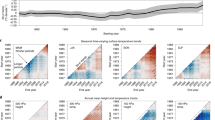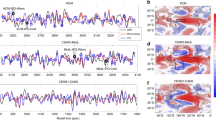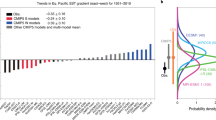Abstract
The Pacific sector of Antarctica, including both the Antarctic Peninsula and continental West Antarctica, has experienced substantial warming in the past 30 years. An increase in the circumpolar westerlies, owing in part to the decline in stratospheric ozone concentrations since the late 1970s, may account for warming trends in the peninsula region in austral summer and autumn. The more widespread warming in continental West Antarctica (Ellsworth Land and Marie Byrd Land) occurs primarily in austral winter and spring, and remains unexplained. Here we use observations of Antarctic surface temperature and global sea surface temperature, and atmospheric circulation data to show that recent warming in continental West Antarctica is linked to sea surface temperature changes in the tropical Pacific. Over the past 30 years, anomalous sea surface temperatures in the central tropical Pacific have generated an atmospheric Rossby wave response that influences atmospheric circulation over the Amundsen Sea, causing increased advection of warm air to the Antarctic continent. General circulation model experiments show that the central tropical Pacific is a critical region for producing the observed high latitude response. We conclude that, by affecting the atmospheric circulation at high southern latitudes, increasing tropical sea surface temperatures may account for West Antarctic warming through most of the twentieth century.
This is a preview of subscription content, access via your institution
Access options
Subscribe to this journal
Receive 12 print issues and online access
$259.00 per year
only $21.58 per issue
Buy this article
- Purchase on Springer Link
- Instant access to full article PDF
Prices may be subject to local taxes which are calculated during checkout




Similar content being viewed by others
References
Vaughan, D. G. et al. Recent rapid regional climate warming on the Antarctic Peninsula. Clim. Change 60, 243–274 (2003).
Steig, E. J. et al. Warming of the Antarctic ice sheet surface since the 1957 International Geophysical Year. Nature 457, 459–462 (2009).
Goose, H. et al. Consistent past half-century trends in the atmosphere, the sea ice and the ocean at high southern latitudes. Clim. Dyn. 33, 999–1016 (2009).
Cullather, R. I., Bromwich, D. H. & VanWoert, M. L. Spatial and temporal variability of Antarctic precipitation from atmospheric methods. J. Clim. 11, 334–367 (1998).
Rignot, E. et al. Recent Antarctic ice mass loss from radar interferometry and regional climate modelling. Nature Geosci. 1, 106–110 (2008).
Thompson, D. W. J. & Solomon, S. Interpretation of recent Southern Hemisphere climate change. Science 296, 895–899 (2002).
Marshall, G. J. et al. Causes of exceptional atmospheric circulation changes in the Southern Hemisphere. Geophys. Res. Lett. 31, L14205 (2004).
Kwok, R. & Comiso, J. C. Spatial patterns of variability in Antarctic surface temperature: Connections to the Southern Hemisphere Annular Mode and the Southern Oscillation. Geophys. Res. Lett. 29, 1705 (2002).
Schneider, D. P., Steig, E. J. & Comiso, J. C. Recent climate variability in Antarctica from satellite-derived temperature data. J. Clim. 17, 1569–1583 (2004).
Johanson, C. M. & Fu, Q. Antarctic atmospheric temperature trend patterns from satellite observations. Geophys. Res. Lett. 34, L12703 (2007).
Karoly, D. J. Southern hemisphere circulation features associated with El Niño-Southern Oscillation events. J. Clim. 2, 1239–1252 (1989).
Garreaud, R. D. & Battisti, D. S. Interannual ENSO and interdecadal ENSO-like variability in the Southern Hemisphere tropospheric circulation. J. Clim. 12, 2113–2123 (1999).
Harangozo, S. A. The relationship of Pacific deep tropical convection to the winter and springtime extratropical atmospheric circulation of the South Pacific in El Niño events. Geophys. Res. Lett. 31, L05206 (2004).
Bromwich, D. H., Monaghan, A. J. & Guo, Z. Modelling the ENSO modulation of Antarctic Climate in the late 1990s with the Polar MM5. J. Clim. 17, 109–132 (2004).
Latif, M., Kleemann, R. & Eckert, C. Greenhouse warming, decadal variability, or El Niño? An attempt to understand the anomalous 1990s. J. Clim. 10, 2221–2239 (1997).
Ashok, K., Behera, S. K., Rao, S. A., Weng, H. & Yamagata, T. El Niño Modoki and its possible teleconnection. J. Geophys. Res. 112, C11007 (2007).
Schneider, D. P. & Steig, E. J. Ice cores record significant 1940s Antarctic warmth related to tropical climate variability. Proc. Natl Acad. Sci. 105, 12154–12158 (2008).
Lachlan-Cope, T. & Connolley, W. Teleconnections between the tropical Pacific and the Amundsen-Bellinghausens Sea: Role of the El Niño/Southern Oscillation. J. Geophys. Res. 111, D23101 (2006).
Bromwich, D. H., Fogt, R. L., Hodges, K. I. & Walsh, J. E. A tropospheric assessment of the ERA-40, NCEP, and JRA-25 global reanalyses in the polar regions. J. Geophys. Res. 112, D10111 (2007).
Uppala, S. M. et al. The ERA-40 re-analysis. Q. J. R. Meteorol. Soc. 131, 2961–3012 (2005).
Kanamitsu, M. et al. NCEP-DOE AMIP-II Reanalysis (R-2). Bull. Am. Meteorol. Soc 83, 1631–1643 (2002).
Comiso, J. C. Variability and trends in Antarctic surface temperatures from in situ and satellite infrared measurements. J. Clim. 13, 1674–1696 (2000).
Bretherton, C. S., Smith, C. & Wallace, J. M. An intercomparison of methods for finding coupled patterns in climate data. J. Clim. 5, 541–560 (1992).
Wallace, J. M., Smith, C. & Bretherton, C. S. Singular value decomposition of wintertime sea surface temperature and 500-mb height anomalies. J. Clim. 5, 561–576 (1992).
Held, I. M. in Large-Scale Dynamical Processes in the Atmosphere (eds Hoskins, B. J. & Pearce, R.) 127–168 (Academic, 1983).
Gill, A. E. Some simple solutions for heat induced tropical circulation. Q. J. R. Meteorol. Soc. 106, 447–462 (1980).
Mo, K. C. & Higgins, R. W. The Pacific–South American modes and tropical convection during the Southern Hemisphere winter. Mon. Weath. Rev 126, 1581–1596 (1998).
Hoskins, B. J. & Karoly, D. J. The steady linear response of a spherical atmosphere to thermal and orographic forcing. J. Atmos. Sci. 38, 1179–1196 (1981).
Yuan, X. & Martinson, D. G. Antarctic sea ice extent variability and its global connectivity. J. Clim. 13, 1697–1717 (2000).
Roeckner, E. et al. Max Planck Institut für Meteorologie Report 218, 90 (1996).
Smith, T. M., Reynolds, R. W., Peterson, T. C. & Lawrimore, J. Improvements to NOAA’s historical merged land–ocean surface temperature analysis (1880–2006). J. Clim. 21, 2283–2296 (2008).
Schneider, D. P. et al. Antarctic temperatures over the past two centuries from ice cores. Geophys. Res. Lett. 33, L16707 (2006).
Meehl, G. A. et al. in IPCC Climate Change 2007: The Physical Science Basis (eds Solomon, S. et al.) (Cambridge Univ. Press, 2007).
Xie, S-P. et al. Global warming pattern formation: Sea surface temperature and rainfall. J. Clim. 23, 966–986 (2010).
Bromwich, D. H. & Fogt, R. L. Strong trends in the skill of the ERA-40 and NCEP–NCAR reanalysis in the high and midlatitudes of the Southern Hemisphere, 1958–2001. J. Clim. 17, 4603–4619 (2004).
Rayner, N. A. et al. Global analyses of sea surface temperature, sea ice, and night marine air temperature since the late nineteenth century. J. Geophys. Res 108, 4407 (2003).
Smith, T. M., Reynolds, R. W., Peterson, T. C. & Lawrimore, J. Improvements to NOAA’s historical merged land–ocean surface temperature analysis (1880–2006). J. Clim. 21, 2283–2296 (2008).
Turner, J. et al. The SCAR READER Project: Toward a high-quality database of mean Antarctic meteorological observations. J. Clim. 17, 2890–2898 (2004).
Acknowledgements
This work was supported by the US National Science Foundation, grant numbers OPP-0837988 and 0963924. We thank G. Hoffman for providing the code for ECHAM4.6, and P. Hezel, A. Jenkins, G. H. Roe, D. P. Schneider and S. Schoenemann for fruitful comments.
Author information
Authors and Affiliations
Contributions
Q.D. did the calculations, implemented the general circulation model experiments, created the figures, and led the writing of the paper. All authors contributed to the experimental design and writing of the paper.
Corresponding author
Ethics declarations
Competing interests
The authors declare no competing financial interests.
Supplementary information
Supplementary Information
Supplementary Information (PDF 1778 kb)
Rights and permissions
About this article
Cite this article
Ding, Q., Steig, E., Battisti, D. et al. Winter warming in West Antarctica caused by central tropical Pacific warming. Nature Geosci 4, 398–403 (2011). https://doi.org/10.1038/ngeo1129
Received:
Accepted:
Published:
Issue Date:
DOI: https://doi.org/10.1038/ngeo1129
This article is cited by
-
Surface warming from altitudinal and latitudinal amplification over Antarctica since the International Geophysical Year
Scientific Reports (2023)
-
Atmospheric trends explained by changes in frequency of short-term circulation patterns
Communications Earth & Environment (2023)
-
Inter-decadal climate variability induces differential ice response along Pacific-facing West Antarctica
Nature Communications (2023)
-
Connection between the Tropical Pacific and Indian Ocean and Temperature Anomaly across West Antarctic
npj Climate and Atmospheric Science (2023)
-
Assessment of future Antarctic amplification of surface temperature change under different Scenarios from CMIP6
Journal of Mountain Science (2023)



